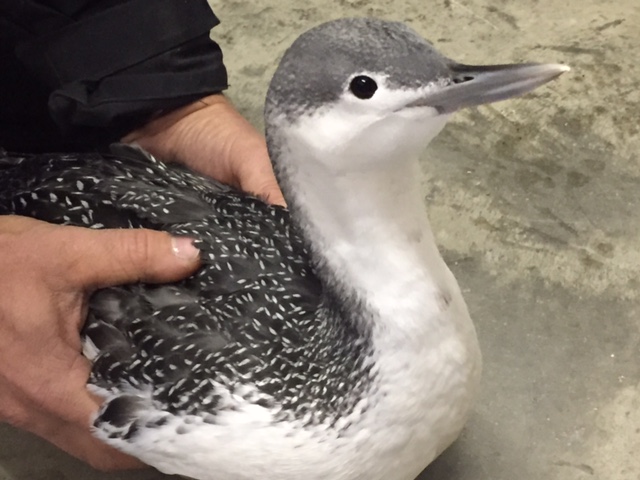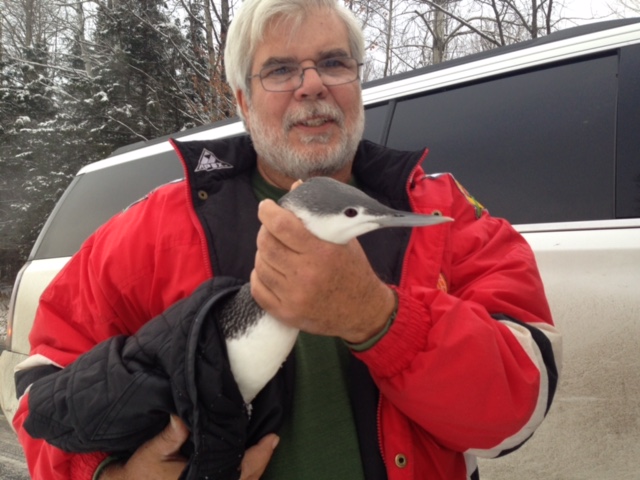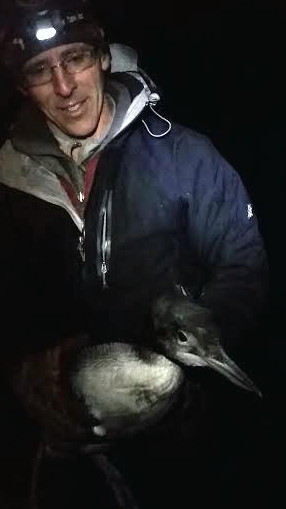
Red-throated Loon posing for the camera. Photo by John Montero
Today might be the day of the turkey for many Americans, but it’s become Red-throated Loon day for me this year. Last night, this exquisite bird was found in the middle of the road along Route 15 in Walden Vermont by local resident, John Montero. The loon likely mistook the pavement for water and crash landed. John grabbed his wife’s coat to see if he could catch it when a state trooper came upon the scene. The trooper put on his flashing lights and assisted in the round-up. Red-throated Loons are tiny in comparison to a Common Loon weighing in at about 2 ½ to 5 pounds. Common Loons in Vermont weigh from 8 to 15 pounds, and one needs to be much more careful when handling the larger species.

John Montero helping a red-throated loon that likely mistook pavement for water. Photo by Kearstyn Montero.
The trooper contacted VFWD game warden Dennis Amsden, who then called me, and 30 minutes later I was in West Danville giving the loon a physical exam with the help of John and his two children. The little boy asked if he could keep the “cute” loon as a pet. The loon appeared to be in fine health minus some minor bruising on the chest. I brought the Red-throated loon to McIndoe Falls in Barnet along the Connecticut River where it could continue its migration toward Delaware Bay and the Chesapeake.
Recent satellite tracking research by Carrie Gray of Biodiversity Research Institute has found that the central Atlantic coast is one area where Eastern North America Red-throated Loons over winter. In the spring, these birds fly north up the coast to the St. Lawrence Seaway and then disperse further north from Labrador to the Hudson’s Bay to find small lakes for breeding. In the fall, the red-throated’s that breed in the Hudson’s Bay region return south via the Great Lakes. We do not know for sure where our Thanksgiving Red-throated loon came from, but it’s neat to imagine it flying 1,500 miles from some tundra lake up in northern Canada.
Second Loon Rescue this FalL
We conducted another loon rescue in Walden back in October, where a chick of the year made a mistake and landed on a shallow marsh pond. Former loon seasonal biologist Angela Apicelli and her 11 year-old daughter Rhea helped me use a night-lighting technique to capture the loon on a 40 F degree blustery evening. In the one to two foot deep water, we could follow the loon under water as it swam. It occasionally followed the spotlight as we approached in the boat. After about 40 minutes, 5 failed netting attempts, and almost knocking Rhea out of the boat once (she was the spot lighter), we nabbed the loon. We released it on nearby Caspian Lake, where it will have plenty of time to practice flying before heading to the New England coast for the winter.

Eric Hanson holding a loon chick who landed on a pond too small to fly from. Photo by Angella Apicelli
Eric Hanson, Vermont Loon Conservation Project Biologist

Wonderful news to share! Happy Thanksgiving, Eric, to you and your family, and thanks for all you do to help loons in Vermont survive and thrive. Jan Parsons
So great to hear your successful rescue stories, Eric! Thanks for sharing, and thanks to the caring folks who help you out.
Thanks, John and Eric! It reminds me of “Little Guy” all over again, seeing your smiling face as you do great work!